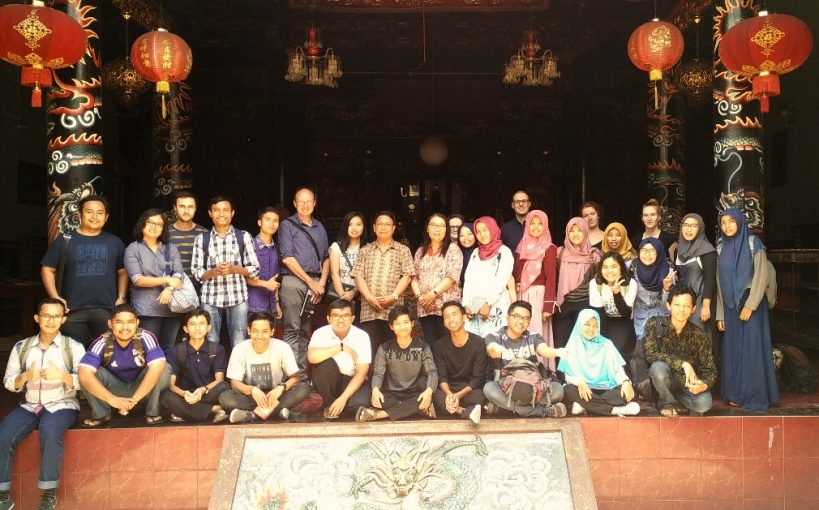
Field trip to the oldest klenteng in Yogyakarta
Mufdil Tuhri – 3 November 2017
On Sunday, October 8, 2017, the World Religions class at CRCS visited the oldest klenteng (Chinese temple) in Yogyakarta, located on Jl. Poncowinatan. Built in 1881, this klenteng we visited is named Tjen Ling Kiong or Zhen Ling Gong, but is more commonly known as Klenteng Poncowinatan. The class had been struggling with questions such as how identity, ritual and culture fit together with teachings and ethics in defining Confucianism as a religion—one of the six state-sanctioned religions in Indonesia. We knew that each klenteng has places to worship deities and holy figures associated with Confucianism, Daoism, and Buddhism, as well as local religions, and we wanted to learn from the perspective of Confucian practitioners.
“Tri Dharma means ‘three teachings’. It expresses the belief system of the ethnic Chinese, consisting of Confucianism, Taoism and Buddhism. Tri Dharma also refers to the place of worship for these three teachings. In Tri Dharma, there are basically three main altars for each. But this klenteng (Chinese temple) is different. The altar is separated into several rooms. This klenteng has two floors with 17 altars, such as Thien Kong, Kwan Tie Koen, Tien Sing Sing Bo, Kong Ce Cun Ong, to name a few. The host for this Klenteng is Kwan Tie Koen,” Cucu Rohyana explained in front of CRCS students, accompanied by the lecturer Gregory Vanderbilt and English instructor Eli Fisher.
Pak Cucu is currently chairman of the Yogyakarta branch of MATAKIN (Majelis Tinggi Agama Konghucu Indonesia or the Supreme Council for the Confucian Religion in Indonesia). Along with his wife Ibu Lifie Rohyana, the secretary of the branch, he welcomed us to the Klenteng and discussed many issues with us.
Confucianism was one of the six officially recognized religions in pre-1965. After 1965, along with the government attempt to crackdown almost everything Chinese, displays of Chinese religiosity were prohibited. These include a ban on public celebrations of Chinese New Year (Imlek). In 1979, Confucianism status was ‘relegated’ to merely culture and not religion—in the still dominant discourse on the politics of religion in Indonesia, culture and religion are understood as separate and distinct from each other.
Pak Cucu recalled his struggle during the New Order when he could not fill in Confucianism in the ID card (KTP)’s religion column and he changed his religion of KTP several times. He and his fellow Confucians had to conduct traditional festivals in private. “Klenteng Poncowinatan was not open to the public back then,” said Pak Cucu.
Circumstances have now changed, since the 1998 Reformation allows more spaces for religious freedom. Confucianism has now become one of the six religions again. “Every time we will hold Imlek, Klenteng Poncowinatan often gets escort from the police to make sure that we can freely and safely hold the rituals and festivals.” Pak Cucu also said that he now often participates in activities with leaders of other religions in the Interreligious Harmony Forum or Forum Kerukunan Umat Beragama (FKUB).
After telling about his experiences, Pak Cucu talked briefly about the Confucian religious tradition. He told us about the two types of incense: the red used for worship in general and the green one for close relatives. The use of incenses is limited from 1, 3 and 9 incenses for each worship practice. Incenses are used in worship to calm the mind, help it to concentrate and meditate. Besides incenses, there are also candles, which have certain symbolic meanings. The red candles symbolize fun or hokki. The longer the candle is lit, the luckier our destiny will be.
“Confucianism emphasizes the importance of practices of honoring the elders,” Pak Cucu continued. Besides, every form of reverence has its own way and philosophy. In general, the honor is conducted by clenching the right hand and closed the left hand. The right hand is understood as symbolizing pride and power while the left hand is of sanctity.

Each level of honor practice has its own purpose. If it is done by elders to the youth, the position of the hand is in the pit of the heart, reminding one to always be patient. The youth to the elders is to the eye, reminding to always keep watching around because the older we are, the more unclear we see. To those of the same age, the position is to the mouth, reminding to always say good to others.
In his final introductory explanation about Confucianism, Pak Cucu talked about the spiritual stages of priestly leadership: Jiaosheng, Wenshu and Zhanglao. When they reach the level of Wenshu and Zhanglao, Confucians are no longer allowed to eat meat; they must be vegetarians. No less important, all levels are open to women.
After his speech, students had many questions. One of the questions concerned the difference between Confucianism in China and in Indonesia. Pak Cucu explained that in general Confucianism in Indonesia is no different from that in China because Confucianism itself comes from China. Perhaps the most significant difference is that, in Indonesia, there must be a recognition of God if what you practice is truly a ‘religion’. Pak Cucu told the story when he received a visit from a student from China who was surprised by the altar of God in the Klenteng, because in China, Confucianism has no concept of an active God.
Before we left for lunch, we went around to see the various altars. The Confucian altar to “Nabi Konghucu” is in the northwest corner of the klenteng, near the altars to some Buddhist figures like Guanyin and the historical Buddha. We could see the challenges for our Confucianist friends of sharing the space and the history of defining themselves as one religion among three, among six, or among many other religions and ways of life.

